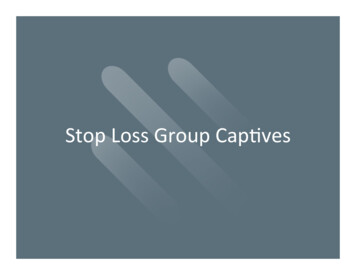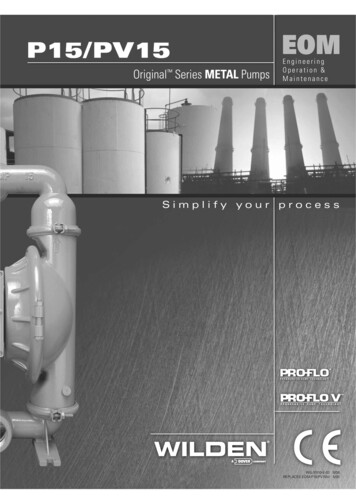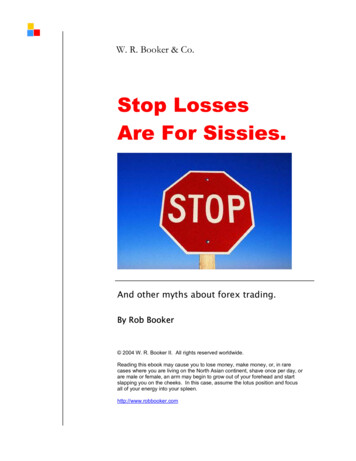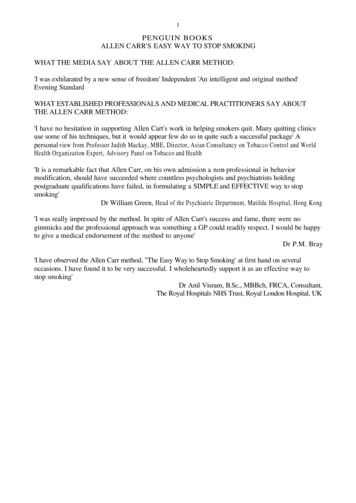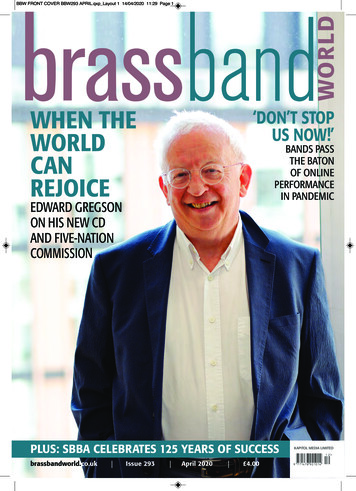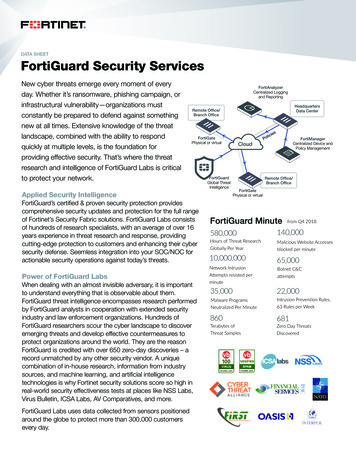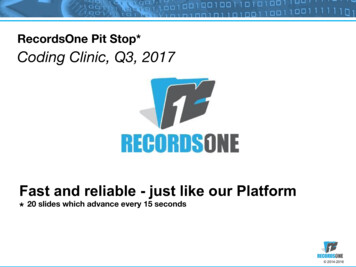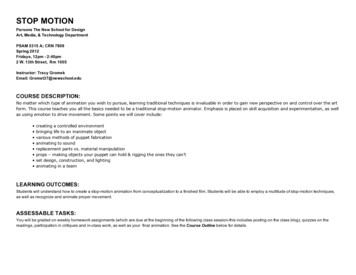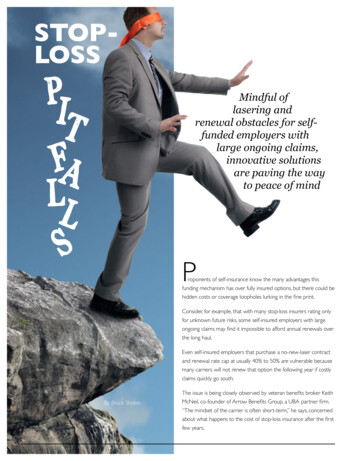
Transcription
STOPLOSSPITFALLSMindful oflasering andrenewal obstacles for selffunded employers withlarge ongoing claims,innovative solutionsare paving the wayto peace of mindProponents of self-insurance know the many advantages thisfunding mechanism has over fully insured options, but there could behidden costs or coverage loopholes lurking in the fine print.Consider, for example, that with many stop-loss insurers rating onlyfor unknown future risks, some self-insured employers with largeongoing claims may find it impossible to afford annual renewals overthe long haul.Even self-insured employers that purchase a no-new-laser contractand renewal rate cap at usually 40% to 50% are vulnerable becausemany carriers will not renew that option the following year if costlyclaims quickly go south.By Bruce ShutanThe issue is being closely observed by veteran benefits broker KeithMcNeil, co-founder of Arrow Benefits Group, a UBA partner firm.“The mindset of the carrier is often short-term,” he says, concernedabout what happens to the cost of stop-loss insurance after the firstfew years.
STOP-LOSS PITFALLS FEATUREMcNeil suggests all carriers have moreflexible contracts that provide theirself-insured customers an extra level ofprotection, even if negotiated at a higherrate – as long as it’s not onerous. Somedo, he happily reports. Other solutionsinvolve purchasing consortiums and groupinsurance captives that aggregate variousarrangements into a single entity or smallnumber of risk pools. The idea is for severalemployers to pool their stop-loss renewalsat the same rate, but add a small laser tothe highest users that won’t break the bank.Under lasering, higher stop-loss coverageattachment points are set for health planmembers with costly claims experienceor an expectation that they will becomehigh-cost claimants. Employers may requestlasering to reduce the fixed cost aspect offinancing their medical benefit plan, explainsMike Kemp, head of accident and health forSwiss Re Corporate Solutions.As self-funding becomes increasingly popular, “more employers are also seeing thedownside” of this arrangement, notes Brad Kopcha, EVP of actuarial services and corporatedevelopment at Benecon. He cites the tradeoff between price and risk, noting that manytimes those that choose a lower fixed cost expose themselves to unforeseen risk.His job is to make employers fully aware of any long-term catastrophic risks they mayencounter. While he considers lasers a valuable risk-management tool, Kopcha raises theimportance of being able to negotiate those terms.While any concern over this common industry practice hasn’t reached a fevered pitch, itcould be bubbling to the surface for self-funded employers with ongoing multimillion dollarclaims driven by costly specialty drugs to treat, say, hemophilia or other medical conditions.Understanding the intent of lasering out costly risks to burnish profit-and-loss statements,McNeil cautions that the process lacks transparency or at least a willingness of somestop-loss carriers or captive managers to level with their customers. On top of that, he’sconcerned that there appears to be a dereliction of duty in essentially transferring risk backto employers without quantifying that risk to the client beforehand.He describes it as “somewhat analogousto the decision to self-fund vs. purchasinga fully insured medical plan. The employeris able to make an informed decision as tothe appropriate trade-off between takingon a variable risk vs. laying off that risk at afixed price based on their unique financialand risk-taking capabilities.”McNeil says there are many scenarioswhere it might work to their advantage. Hisobjection is the “ability of a stop-loss carrierto impose lasers of any amount on amember, no matter how financially cripplingthat might be to the plan sponsor.” At issueis an ability to reasonably manage high-costclaimants who join a self-insured health planlater or the individual wasn’t known to be ahigh risk when the contract took effect.March 2018 The Self-Insurer5
ace of mindWe’ve got your back. Four words that anyone seeking to self-fund healthcare benefits needs to believe,particularly when contemplating the financial risks associated with catastrophic medical events. That’swhy we’re firm believers at Swiss Re Corporate Solutions in building strong relationships, understandingexactly what our partners expect of us, and creating innovative ways of fulfilling those expectations.And that’s also why we’ve integrated IHC Risk Solutions into our business. The result is a powerfulcombination of expertise and capabilities that offers brokers, advisors, payers and their employer clientsenhanced value – not to mention extra peace of mind. Now, more than ever, we’ve got your back.We’re smarter together.swissre.com/eslInsurance products underwritten by Westport Insurance Corporation.
STOP-LOSS PITFALLS FEATUREThere’s also an implication that the employerhas done something wrong when, in fact,McNeil says they’re simply unlucky withregard to workforce demographics. Theultimate fear is that an inability to absorbongoing catastrophic claims could put a selffunded company out of business.Some large brokers are now asking thattheir stop-loss renewal quotes have no newlasers and a rate cap for the first renewal,he reports. “There’s a growing realizationthat it’s a problem, but because it’s rare, it’snot on most people’s radar,” according toMcNeil.At a recent conference he attended, forinstance, McNeil was struck by severalrationalizations industry leaders used tojustify traditional stop-loss renewals allowingpotentially unfettered lasers. One was thatmost employers won’t reach their lasermaximum, while another was given thatspecialty drugs are a driving factor. Thethinking was that certain costly scripts canalways be purchased outside the U.S. orremoved from the formulary in pursuit ofa patient assistance program designed toobtain the drug for free or at a very lowcost.While these and other options can provide help in some cases, they are not something thatcan be relied on in the most extreme cases, he believes. In a nutshell, he’s just not sure whysome carriers that profess to be in the insurance business are unwilling to rate for insuranceprotection that their clients will need in the worst-case scenario. If they are unwilling to doso, he suggests that they at least let the client know how they will handle a renewal in aworst-case scenario for exceeding years, not just the next renewal.Theoretical discussionsTo be fair, concern about lasering and costly stop-loss renewals involve claims that are veryrare relative to other risks, and therefore, not top of mind for industry leaders. Kemp hasheard discussions about these issues in a theoretical context, but never involving a practicalapplication.One brow-raising example that McNeil learned about through the proverbial grapevineinvolved an employee whose cancer symptoms were first diagnosed in mid-year. If the stemcell transplant estimated to cost between 250,000 and 1 million he eventually neededhad been paid in year one of the policy when it was done, the spec would have been just 60,000.But because it wasn’t settled until year two, the carrier excluded that individual on renewal(not even a specified laser), though he still was covered by the plan at the full risk of the plansponsor. That meant the self-insured employer was able to find a 250,000 laser somewhereelse. Fellow brokers with whom he shared this story and have generally agreed in principleto reasonably priced lasers were surprised by this account.The fundamental issue as Kemp sees it involves the potential impact to severe, ongoingsituations and how a no-new-laser is handled at renewal. Acknowledging the advent ofspecialty drugs can heighten angst, especially as they become more widely used, Kemp alsopoints out the potential for lifetime catastrophic costs has always been part of the equation.Actuarial AdvisorOur Complete First Dollar and Excess LossPricing Manual for Medical and Rx Planswww.windsorstrategy.solutionsTHE MOST COMPREHENSIVE AND FLEXIBLE ACTUARIAL RATING MANUAL AVAILABLE TODAYMarch 2018 The Self-Insurer7
STOP-LOSS PITFALLS FEATUREWith regard to mitigating high rate increases at renewal, he has seen options in the marketfor as low as 30% or 35. “But I would also argue that even a 40% or 50% renewal of thestop-loss premium, in most cases, should not be viewed as financially catastrophic to anemployer because the stop-loss premium itself typically represents about 20% or so of theirtotal medical benefits spend,” Kemp explains. Therefore, he says “it needs to be put intoperspective” when considering the total benefits spend.The actuarial vs. underwriting debateWhether frustration over lasering contracts and stop-loss renewals involving ongoingcatastrophic claims may or may not be mounting across the self-insurance community, someservice providers are poised to assist.Contribution Health, Inc., which offers self-funded employers stop-loss purchasing strategiesamong other specialty services, uses actuarial management, a spread-of-risk approach andpurchasing power amassed over several years instead of lasers. It views high prices for nolaser guarantees as double payment for the same coverage.“Isn’t stop loss supposed to cover large claims without paying an extra 10% to guaranteethey cover the large claim?” according to the company’s marketing materials. “We think largeclaims should be spread across the pool at no extra cost.”8The Self-Insurer www.sipconline.netNo-laser contracts are confined to largeremployers and accompanied by a rateincrease of 8% to 10% and 50% rate capon renewal, explains Rick Burd, president ofContribution Health.“Stop-loss insurancecompanies are generally inthe business of avoiding risk,not taking risk,” he says, referencingan operating philosophy that each group hasto be profitable each year. “That’s whythey are full of underwritersas opposed to actuaries.Underwriters avoid risk;actuaries pride themselves inmanaging risk. Our programsare designed to pay a fair riskpremium, but we have suchtrouble finding risk partnerswilling to take risk.”
A medical stop lossgrand slam.A trusted business name.A stellar balance sheet. An executive team with30 years of experience. Creative, tailored solutions.Berkshire Hathaway Specialty Insuranceis proud to bring our exceptional strength,experience and market commitmentto the medical stop loss arena.It’s a home run foryour organization.www.bhspecialty.com/mslAsheville Atlanta Boston Chicago Houston Irvine Indianapolis Los Angeles New York San Francisco San Ramon SeattleStevens Point Auckland Brisbane Dublin Düsseldorf Hong Kong Kuala Lumpur London Macau Melbourne Singapore Sydney Toronto
STOP-LOSS PITFALLS FEATUREthat financial safe zone,we help them reducethe cost of health care,”he adds.Any effort to removelasers from the industrywould likely have tohappen on a state-bystate basis given thatregulatory structure,Cavenagh points out. “Ithink the big stop-losscarriers would love it,The lasering issue raises a largerphilosophical issue about stop loss, accordingto Burd. “The interesting subtext to all thisis the cultural clash of avoiding risk versusspreading risk,” he observes, noting how itinfluences pricing, renewals, contracts andclaim adjudication.There are others in the self-insurancecommunity who have adopted his thinkingand even used it as their raison d’être. “Ourbusiness is designed to solve this issue,”says Andrew Cavenagh, managing directorand founder of Pareto Captive Services,LLC. As part of the company’s model,employers cannot get a laser for a newcondition that appears after they join one ofPareto’s programs. Also, the largest stop-losspremium increase Pareto has ever given is30%.By adopting this approach with lasering,Cavenagh says self-insurance is madepalatable for employers with between 50and 400 employees. “Once we’ve created10as they could assumethe volatility more easilythan smaller stop-losscarriers, giving them acompetitive advantage,”he observes. “It wouldprobably lead toincreased consolidation in stop-loss carriers and fewer choices for employers.”Benecon has offered a program for nearly five years that mitigates lasers and other pitfallsassociated with placing stop loss on an annual basis for self-insured employers. The effortincludes 15 consortiums with 1 billion of premium equivalent flowing annually through 843self-funded accounts and more than 90% retention.The largest program, called VERIS, serves about 300 private employers with stop-lossconsulting services to ensure they’re entering into a stop-loss arrangement with adequateprotection against high-dollar claims. Kopcha says it smoothes out any increases without theneed for lasers. VERIS is posting double-digit growth, which he attributes to a combination of“expertise and volume in this space,” as well as cooperation with stop-loss carriers.Despite the solutions at hand to make stop-loss coverage more affordable for groups withunusually high risks, scores of self-insured employers may not even be aware of them. McNeilreferences a scene in the film “Big Jake” starring John Wayne during which a sheepherder isabout to be hanged by cattle ranchers. To save his life from the ranchers, Big Jake asks if he’swilling to sell his sheep to him. When Big Jake offers a certain price, the sheepherder calls ithighway robbery, but then is asked if he thinks he’s going to get a better offer that day.“Our clients with large catastrophic ongoing claims are the sheepherder with a noosearound the neck, and if they have not planned ahead and selected the right stop-loss vendor,then they may end up in the same position,” he quips.Bruce Shutan is a Los Angeles freelance writer who has closely covered the employee benefitsindustry for 30 years.The Self-Insurer www.sipconline.net
and founder of Pareto Captive Services, LLC. As part of the company’s model, employers cannot get a laser for a new condition that appears after they join one of Pareto’s programs. Also, the largest stop-loss premium increase Pareto has ever given is 30%. By adopting this app
